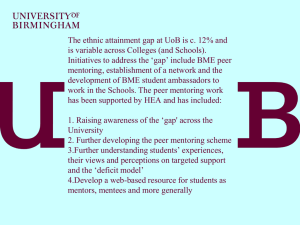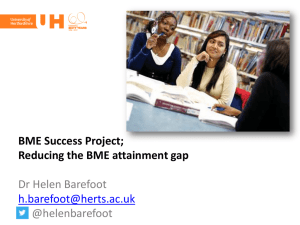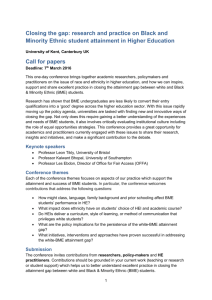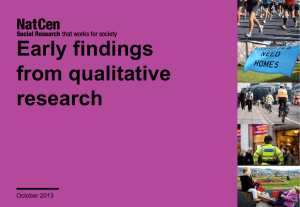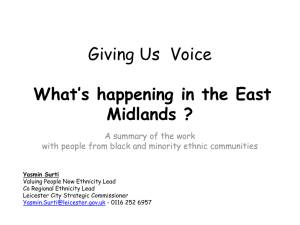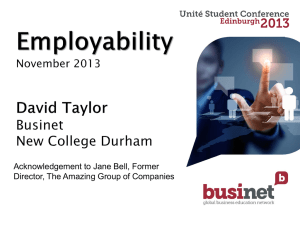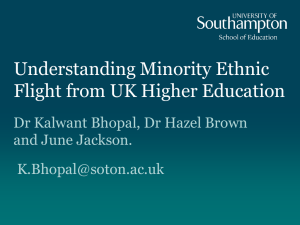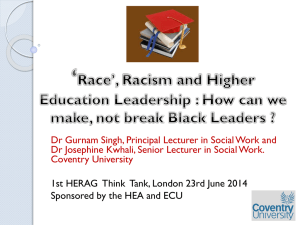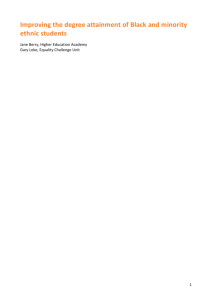A161-SFlynnJBaines
advertisement
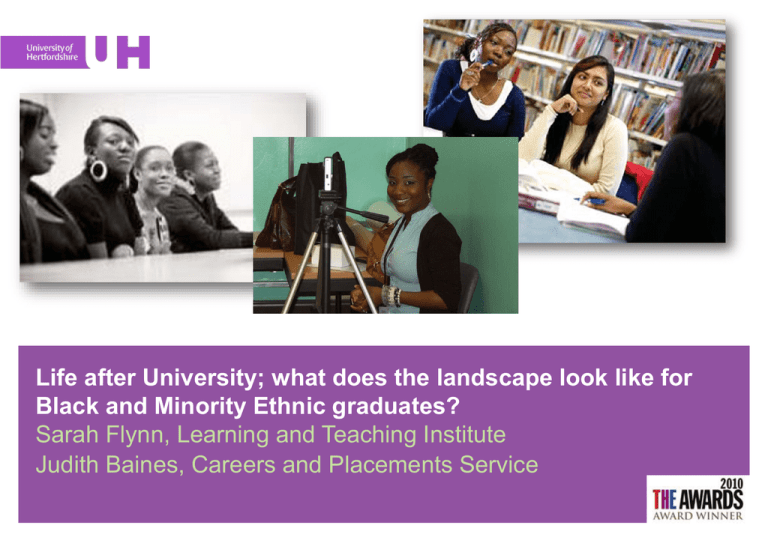
Life after University; what does the landscape look like for Black and Minority Ethnic graduates? Sarah Flynn, Learning and Teaching Institute Judith Baines, Careers and Placements Service Objectives of the presentation • Recent activities have raised awareness within the university sector of the attainment gap that exists between BME and non-BME students. But what about life after university? This presentation will take a look at the available literature surrounding the destinations and career opportunities of BME graduates at a national level. We hope to… • • • Draw attention to the sources of data that we have available to help inform our practice Raise awareness of the additional challenge that is faced by a significant proportion of the UH population of graduating students Encourage action to help give our BME students the best possible entry into the labour market that we can The stark reality… • BME graduates are less likely to possess a good degree leaving university, and more than three times as likely to be unemployed after graduation as compared to White UK and Irish students (The Bow Group, 2012) • 56.2% of all white respondents secured full-time paid employment within six months, compared to 48.2% of all BME respondents and 55% of all graduates. (AGCAS, 2008) • 10.1% of all BME respondents were believed to be unemployed, compared to 5.7% of white respondents and 6.4% of graduates overall. (AGCAS, 2008) • Of those in work, 47.8% of Black / Black British graduates are in non-graduate occupations, compared to 37.4% of white graduates and 37.4% of graduates overall. (AGCAS, 2008) The most recent data shows no shift… Equality Challenge Unit, Equality in Higher Education Statistical Report 2012 • • • • • Over the past eight years, the proportion of UK-domiciled BME students increased from 14.9% to 18.4% (2003/04 – 2010/11) The largest increase has been in the proportion of UK-domiciled black students, which has risen from 4.4% to 5.9%; the proportion of UK-domiciled mixed race students has doubled from 1.4% to 2.8% over the same period In SET subjects, 68.1% of UK-domiciled white qualifiers obtained a “good” degree, compared with 52.1% of BME qualifiers – an attainment gap of 16% In non-SET subjects, 70.4%of UK-domiciled white qualifiers obtained a “good” degree, compared with 50.4% of BME qualifiers – and attainment gap of 20% 53% of white UK-domiciled leavers were in FT paid work, including self employment, compared with 43.3% of BME leavers. Black or black British African leavers were least likely to be in FT paid work (38.4%) and most likely to be assumed to be unemployed (16.3%) The UK-domiciled student population 2010/11 What does this look like at UH? We know the attainment gap exists… What about graduate destinations? We know the attainment gap exists… What about graduate destinations? The bottom line… Known to be more prevalent amongst BME graduates: • Lack of full time employment • Under employment • Unemployment • BME students account for over half of the UH student population – therefore this is a significant issue for our students and graduates, and therefore is a significant challenge for all of us Are the students aware of this? • Even if they were able to achieve a good degree or qualification, existing discrimination within the workplace meant that their educational background would have little impact on their career and job prospects, greatly affecting their motivation to succeed • “I think most students from ethnic communities believe no matter how well [they] do there is a ceiling on their career progression compared to whites”. Black British HE student • “The job prospects for minority people are limited as compared to their white counterparts. Therefore, they feel less encouraged because they know they will be struggling for jobs even when they get qualified”. Black African FE student Have we considered all the barriers? THE, 24th January 2013 reported on research from academics at Leeds Metropolitan University saying that black students… • Feel less able to approach their lecturers with problems • Are less confident in their academic abilities and blame themselves if they don’t understand rather than ask • Feel more self-reliant and that they had to resolve things themselves, particularly those with experience of being “rebuffed” by those in authority positions • Good at establishing informal support networks • Report internalised negative racial stereotypes, particularly black male students who said “they did not feel good enough” We need to work harder to ensure BME students access and use all the support that is available to them So what do we do about it? Key negative factors • Social deprivation • Low social capital • Racism • Poor self-esteem Key positive factors • Engaging families • Linking university with the wider community (professional and cultural) • Influence of membership groups (like religious affiliations) Byfield, 2008 • Framework of love • Positive and consistent interventions Sewell (2009) • • • • Role models Mentoring and support – non traditional students recruited through WP routes suffer more if support is remote Labelling Reinforcement of stereotypes So what do we do about it? Dealing with those negative factors… • Social deprivation – make sure students know about all the UH resources (academic and pastoral), look for opportunities to signpost free resources / activities, no-cost / low-cost is key here, paid work experience as opposed to voluntary internships • Low social capital – look for opportunities to introduce students to the networks they need for entering work, like encouraging well-prepared attendance at Careers and Placements events, building interpersonal and social skills where you can • Racism – work to make your classrooms inclusive places, make your learning, teaching and assessment environment fair, safe and without bias • Poor self-esteem – think about the language you use with your feedback, in general and on assessment, build confidence with clear signposting for improvement So what do we do about it? – Your turn Working with the positive factors • Engaging families • • Linking university with the wider community • • Influence of membership groups (like religious affiliations) Framework of love Positive and consistent interventions • Role models • Mentoring and support What do we have planned? Don’t forget other UH policies and practice will help… • Graduate Attributes • Student Charter • Embedded work experience • Employability through the curriculum Identification of diversity positive schemes and promotion of these to the students • Work experience • Graduate employers • Mentoring • Professional bodies References 1. 2. 3. 4. 5. 6. The Bow Group (2012) Race to the Top; the experience of black students in HE AGCAS (2008) What Happens Next? A report on ethnicity and the first destinations of graduates Equality Challenge Unit (2012) Equality in Higher Education Statistical Report 2012 NUS (2011) Race for Equality; a report on the experiences of black students in FE and HE C Byfield (2008) Black boys can make it T. Sewell (2009) Generating genius: black boys in search of love, ritual and schooling Sarah Flynn, s.j.flynn@herts.ac.uk Judith Baines, j.baines@herts.ac.uk
